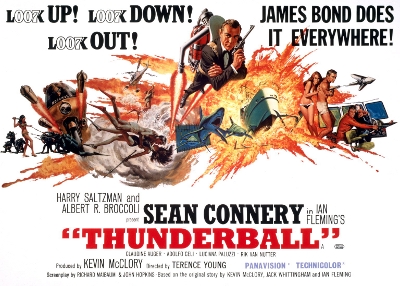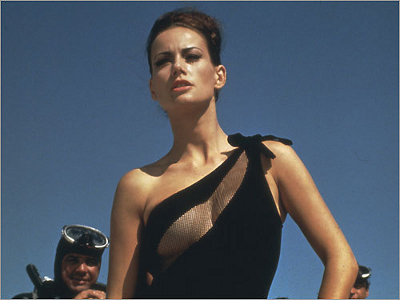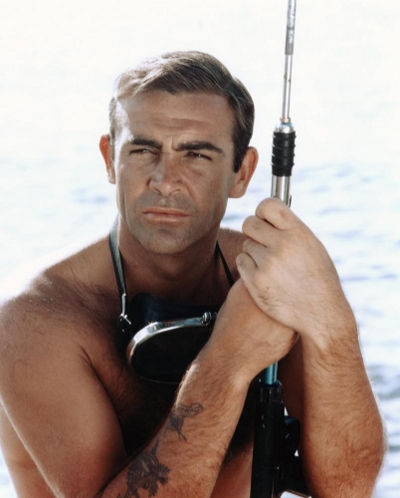|
The Big Blue! - A Look Back At Thunderball

Sean
Connery IS James Bond. Few film taglines have such an iconic and
enduring aura of authenticity and verisimilitude. Thunderball (released
in 1965) was the fourth entry in the James Bond series and the first to
be shot in the widescreen format of Panavision. It was directed by
Terence Young and written by Richard Maibaum and John Hopkins from a
story by Ian Fleming, Kevin McClory and Jack Whittingham. Thunderball
was the first truly epic James Bond film and remains one of the more
debated entries in the apparently indestructible franchise. Some feel
the film becomes bogged down in too many laborious underwater sequences
while others argue that this is the most gloriously Bondian picture in
the series and the one that most reflects the predilections, tastes and
world view of Ian Fleming. I think the real truth probably lies
somewhere in between. This is an elegant and stylish film rife with
panache, wit, escapism and beautiful sun drenched locations but a
somewhat more brusque edit might have been in order. Thunderball was
allocated a then astronomical budget of £2.5 million (over five times
that spent on 1962's Dr No) in order to do justice to the extensive and
innovative underwater set-pieces in the screenplay and comfortably
remains - adjusted for inflation - the highest grossing James Bond film
of all time. It's no exaggeration to say that Thunderball was the Star
Wars or Lord of the Rings of the sixties. Some cinemas in the United
States even resorted to screening the film 24 hours a day to cope with
public demand. While it might not be the very best Bond film (I prefer
From Russia with Love, Goldfinger and On Her Majesty's Secret Service
from this decade alone), Thunderball marked the apex of sixties
Bondmania and featured perhaps the best of Sean Connery's seven
performances as the suave super spy. Graceful, ruthless, sardonic,
witty, cruel, snobbish and charming, Connery - to borrow an
appropriately aquatic metaphor - prowls through Thunderball like a
shark, safe in the knowledge that the villains don't stand a chance!
Thunderball
revolves around an audacious scheme by global terrorist organisation
SPECTRE ((Special Executive for Counter-intelligence, Terrorism,
Revenge and Extortion!) to hold world governments to ransom by
hijacking two nuclear warheads from a Vulcan bomber. The Vulcan
carrying the bombs is craftily hijacked by a SPECTRE operative who has
undergone plastic surgery to pose as a NATO pilot (both roles are
played by Paul Stassino). Once in control of the plane, the operative
lands it in the middle of the ocean near the Bahamas where our
eye-patch wearing villain Emilio Largo (Adolfo Celi) - known as "Number
Two" in SPECTRE - and his henchmen take the warheads from the seabed
and hide the plane. The operative is of course done away with for his
troubles. A ransom demand is sent to the British and American
governments by Blofeld (still hidden in the shadows at this point in
the series but played by Anthony Dawson and voiced by Joseph Wiseman)
warning that if one hundred million dollars is not paid within a week
then a "major" piece of property will be destroyed - followed by a
famous city. "My dear Prime Minister, two atomic bombs, numbers, 456
and 457. Which were aboard NATO Flight 759, are now in the possession
of SPECTRE... " Meanwhile, British Secret Agent James Bond stumbles
into unexpected intrigue while staying at a plush health farm named
Shrublands when he notices a criminal gang tattoo on the arm of a
patient named Count Lippe (Guy Doleman) and survives an attempt on his
life. When he discovers a dead man wrapped in bandages he later
identifies him as the NATO pilot used by SPECTRE to hijack the Vulcan.
The pilot's sister is Dominique "Domino" Derval (Claudine Auger) and
just happens to be Largo's mistress. Bond is duly sent to the Bahamas
to make contact with Domino and investigate Largo. The plan to track
down the warheads and foil Blofeld's fiendish ransom plot is given the
codename Operation Thunderball.
Sean
Connery's encroaching boredom with the role that made him famous
manifested itself much more in 1967's You Only Live Twice than here and
Thunderball is consequently special for this reason. It feels like the
last entry where his heart was in it. Connery hated making the films.
He felt he wasn't paid enough, yearned to do more serious roles,
loathed the long hours and constant media attention and would roll his
eyes when he was frequently asked to sign autographs James Bond rather
than his real name. Legend has it that he decided he'd finally had
enough of being James Bond when a Japanese fan followed him into the
toilet to ask for an autograph during the shooting of You Only Live
Twice. James Bond was as famous as The Beatles but there were four of
them to share the strains and burdens of pop culture hysteria. Connery
was all alone. Thunderball promised - in the grand larger than life
Cubby Broccoli tradition - to be bigger (Look Up! Look Down! Look Out!
Here Comes The Biggest Bond Of All!) than anything the glittering
series had thrown at the screen yet and is true to its word. There are
however one or two caveats - most notably the lengthy underwater
sequences which take up nearly a quarter of the running time of the
film. The most popular and common criticism of Thunderball is that it
should have been more streamlined and even its director Terence Young
later expressed this view when reflecting on the picture. For all its
frequent wonder and escapist magic, Thunderball does become rather
waterlogged and dull in places. I think one of the problems is that
underwater sequences lack the freshness to modern eyes that they did in
1965. While some of the aqua photography could safely have been culled
these sequences are superbly done and were very radical for the time.
The photography by Lamar Boren is stunning.

One other
quibble that is apparent in Thunderball (and this is a common fault of
older Bond films) is that it features some jarringly poor back
projection work, especially during climatic scenes at sea. Again, this
was probably less of a problem to audiences in the sixties but it's an
element that dates the film badly at times. There is much to enjoy away
from the water here though - right from the pre-title sequence. This is
essentially a rehash of the PTS fisticuffs of Goldfinger, only in
Panavision, on a bigger budget and with a gadget laden coda featuring a
Jet Pack ("No well dressed man should be without one...") and Bond's
trusty Aston Martin DB5. This glossy opening to the picture was shot at
Chateau d'Anet, 40 miles outside of Paris. Bond is there to observe the
funeral cortege of SPECTRE assassin Jacques Boivard but isn't convinced
he is really dead. It all leads to an enjoyably stylised fight sequence
in one of the Chateau's beautifully furnished and cavernous rooms.
Equally enjoyable are Maurice Binder's excellent watery aquatic
Panavision titles and Tom Jones belting out the theme song ("He looks
at this world and wants it all... and he strikes... like
Thunderball!"). The song probably would have been even better sung by a
woman (Bond songs sung by men never quite seem right for some reason)
with a good pair of lungs but you can't fault Tom for effort. It goes
without saying that John Barry's score is one of incomparable elegance,
both majestic and spine-tingling. If it was Ken Adam that made us
understand what a Bond film should look like then it was John Barry
that taught us what it should sound like. His Bond scores, like James
Bond himself, really will be forever.
Thunderball
has been accurately called the first epic Bond film and one can see
why. By now, the Bond blueprint/formula (exotic locations, casinos,
violent action, beautiful women, gigantic set pieces, deadpan humour,
outlandish gadgetry) was firmly in place and the approach of producers
Cubby Broccoli and Harry Saltzman was simple. The budget goes up on the
screen for the audience to see and each Bond seeks to be more
spectacular than the last one - like a series of escalating explosions.
Amidst the mayhem though there is a rich sense of panache and style
that permeates every pore of Thunderball. This is all in no small way
down to Terence Young, who supplies chic direction and stunning 'wipes'
from one scene to the next. It was Young (who was a very refined,
dapper and pefectly dressed chap himself) who had to take Sean Connery
in hand and make sure he looked the part. "That f***ing truck driver,"
Ian Fleming is said to have remarked about Sean Connery after he was
cast as James Bond. Well, he soon changed his tune. Young took Connery
to famed shirt-maker Turnbull & Asser for custom-designed shirts
with turnback cuffs and had his tailor Anthony Sinclair cut the actor's
suits. Connery scrubbed up quite nicely, his elegant panther like Bond
making Daniel Craig look like he's just spent three days living rough
on the streets. Style was key to quickly communicating the character of
Bond. Young infused some of his own personal sense of style into Bond
and this resonated well with audiences.
With
jet-packs, mini cruise-ships that separate, DB5 water canons,
radio-active pills, an underwater jet-harness, exploding chairs etc,
Thunderball is heavy on the gadgets but the leading man is never
(pardon the pun) lost at sea and remains the spiffy focal point of the
film. If one can get past the more sedate and overlong aquatic
sequences there are some wonderful moments and set-pieces. A rocket
firing motorcycle chase, the gargantuan production design by Ken Adam,
the climactic battle between SPECTRE frogmen and the US Aquapar forces.
The big battle sequence was a staple of many Connery films (and a
couple of Roger Moore ones too) and something I miss. Modern Bond films
seem rather pathetic in scope compared to the preposterous carnage that
Broccoli and his team would conjure up with reckless abandon. Local
colour is provided by Bond being pursued through a Bahamian parade
known as the Junkamo. Young had the entire parade restaged just for the
film (!) and one has a pleasant image of him urbanely orchestrating
this complicated sequence as he sips champagne from a Styrofoam cup.
The sheer largesse of Thunderball is highlighted by Largo's yacht - the
Disco Volante. It was constructed at a cost of over $100,000 by Ken
Adam when the producers couldn't find a hydrofoil suitable for their
use. Bond's Jet Pack is the the Bell Pack, a prototype from the US Army
and the only model in existence at the time, and a full scale mock-up
of a NATO plane was built. In terms of box-office, spectacle, and
Bondian essence, Thunderball positively dwarfs the films Barbara
Broccoli and her luvvie friends still periodically inflict on the
general public when the mood takes them.
The story
and origin of Thunderball is a remarkably knotty, complicated,
controversial and fascinating one. In the fifties, Ian Fleming
collaborated with writer Jack Whittingham and maverick Irish film
producer Kevin McClory on a screenplay that was supposed to be the
first ever James Bond film. McClory was obsessed with becoming the
first man to put James Bond on the silver screen and envisioned a
widescreen epic set in the West Indies that would make extensive use of
his love of the sea and scuba diving. McClory and Whittingham didn't
think much of Fleming's screenwriting skills at all and also thought a
cinematic Bond should be less starchy and have more humour. They felt
the fantasy world of Fleming should have more logic and the sadism and
torture had to go. McClory commissioned spectacular art to show what a
Bond film should look like - the art evoking the imagery of the films
that Broccoli and Saltzman would make with Sean Connery in the next
decade. The proposed film never went into production but all hell broke
loose when Fleming (in an act of incredible stupidity and arrogance)
later used the screenplay as the basis for his 1961 Thunderball novel
without telling Whittingham or McClory or giving them any credit. The
stress of the court case that followed is widely believed to have
hastened Fleming to his grave from another heart attack and the
victorious McClory was left with legal rights to make his own
unofficial Bond film based on Thunderball (which of course he
eventually did with 1983's Never Say Never Again). When Bond producers
Cubby Broccoli and Harry Saltzman adapted Thunderball in 1965 they
shrewdly brought McClory in as a co-producer. Not because they liked
him or valued any contribution he might make but essentially to keep
him quiet and stop him making his own rival Bond film or series to go
up against their money strewn phenomenon. (As part of his contract for
co-producing Thunderball, McClory was obliged to agree not to produce
his own renegade James Bond until ten years had passed. Of course,
Broccoli wrongly assumed Bond would long have fizzled out by then.
McClory would be a legal thorn in his side for decades to come).

Thunderball
has trademark moments of Ian Fleming sadism scattered through the book
with electrocutions, burns, barracudas (a ray-finned fish known for its
large size and fearsome appearance), and assorted deaths. It's the
languid tropical atmosphere though that is often the star of the film
with Nassau in particular looking like a suitably exotic and glamorous
playground for the action to unfold. "Now he swam very slowly, watching
the white explosion of the moon on the surface contract and define
itself," wrote Fleming. "Once he looked down. There was no sign of the
barracuda. The long hull of the ship grew out of the upper mists and
took shape, a great Zeppelin in the water." Thunderball sticks closely
to the novel and successfully captures the spirit of the source
material. One difference I suppose is that Largo is more of a central
character here (and, somewhat confusingly, his SPECTRE designation is
also different). Largo is not up to Auric Goldfinger and Red Grant in
the pantheon of sixties Bond villains but he is suitably stylish and
menacing at times. "You've given me much pleasure Domino. But in
return, unless you tell me how much Bond knows, I'll be forced to cause
you great pain!" Adolfo Celi (dubbed by Robert Rietty) certainly looks
like a Bond villain with his urbane manner and eye-patch.
The
ravishing Luciana Paluzzi as SPECTRE agent Fiona Volpe, more than
willing to use her sexuality to send her enemies to their doom, makes
an excellent second villain although Claudine Auger (a former Miss
France) is slightly less effective in the pivotal role of Dominique
"Domino" Derval. She's dubbed (very well) but perhaps lacks presence
sometimes. Looks great in a swimming costume though and is
appropriately moody. A mention must go to Rik Van Nutter as Bond's CIA
friend Felix Leiter. The Bond series has constantly recast the part of
Leiter since its inception, mainly without much success. Van Nutter
(great name!) is at least though energetic and boyish (in contrast to
the pudgy Cec Linder in Goldfinger) and displays a believable sense of
camaraderie with Connery's Bond. Look out too for Martine Beswick as
Paula Caplan and Molly Peters as Patricia Fearing, a physiotherapist
Bond meets at Shrublands. Bond's dalliances with Molly are rather
cheeky for a 1965 mainstream blockbuster. Connery of course though is
the best thing about the cast of Thunderball. He looks the part of
James Bond (tall, dark, handsome, as Fleming described) and has the
right mixture of humour and the ability to punch his way out of trouble
if required. He remains the benchmark against which all Bond actors are
judged.
It isn't
perfect by any means but Thunderball is still superb entertainment,
packed with sumptuous locales, beautiful women and exceptional
photography, music and special effects. It comfortably resides
somewhere around the middle of my own list of the ten best James Bond
films ever made. Connery's expertly delivered deadpan humour alone ("Do
you mind if my friend sits this one out? She's just dead!") makes it
worth watching.
- Jake
c 2011
Alternative 007
|

|


